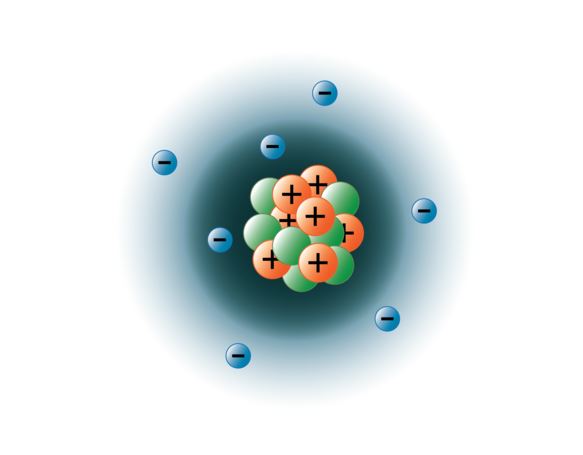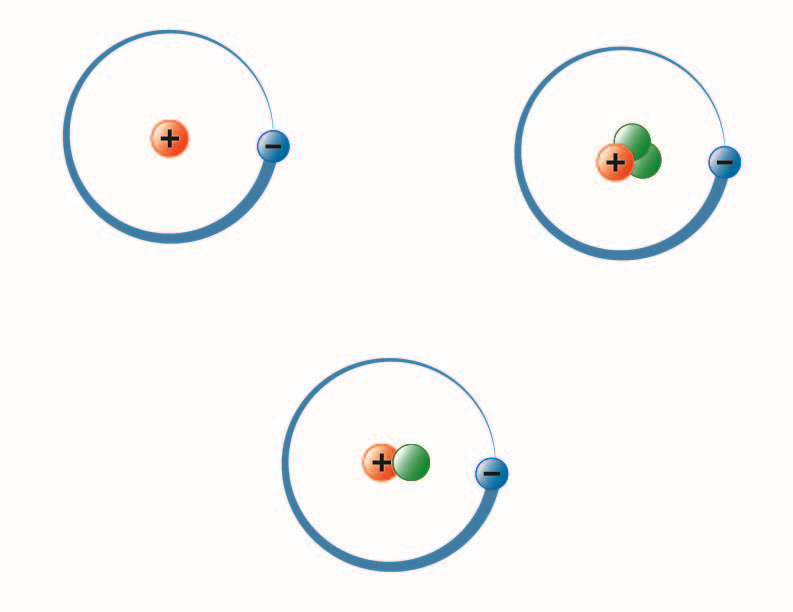Inorganic Chemistry (Atomic Structure) Atoms
Subatomic Particles
All elements are composed of extremely small particles of matter called atoms. We can define an atom as the simplest particle of an element that has the chemical properties of that element. Chemical properties include the physical state of the element (gas, liquid, or solid), the types of bonds the element can form, how it reacts with other elements, etc. Therefore all of the atoms that make up the element carbon have the same chemical properties.
Physicists have succeeded in blasting atoms apart into dozens of different sub-atomic particles, however, only 3 of them are stable. These are the protons, neutrons, and electrons. Protons are positively charged particles, have mass, and are located in the center, or nucleus of the atom. Neutrons have no charge, have mass, and are also located in the nucleus of the atom. Neutrons bind with protons in a way that helps stabilize the nucleus. Too many or too few neutrons may result in an atomic nucleus that is unstable and may decay to form other elements. We refer to these atoms as being radioactive. Although the mass of the neutron is slightly greater than that of a proton we can assign both of them the relative mass of 1 (1 atomic mass unit or amu). Neutrons and protons constitute almost all of an atom’s mass. The third type of stable particle is the electron. Electrons have a negative charge but are extremely small and have a mass only 1/1850 that of a proton or neutron. They are so small that for practical purposes they do not contribute to the mass of the atom. Electrons move around the nucleus at tremendously high speeds, actually travelling at near the speed of light. Although we often describe the electrons as residing in orbits that circle the nucleus, like planets orbiting the sun, modern physics teaches us that this model is incorrect. These “orbitals” are actually areas in space around the nucleus where the electrons will be located most of the time. This area is often referred to as the electron “cloud.” True, it is still a specific area, but it is a bit more amorphous than a spherical orbit. For simplicity, however, we often think of these as satellite-like circular orbitals. The image below represents our current model of a Nitrogen atom.
The nitrogen nucleus contains 7 protons (orange) and 7 neutrons (green). The shaded areas around the nucleus represent the electron orbitals (clouds). Electrons (blue) will be found somewhere within these orbitals. (Note: the image is not drawn to scale. It has been suggested that if the nucleus were the size of a basketball the electrons would be about six kilometers or 3¾ miles away!)

image created by BYU-I student Hannah Crowder Fall 2013
Atomic Number
Take a look at the periodic table again and notice the number at the top of each box. This number is the atomic number for the element and is unique for each different element. For example, the atomic number for hydrogen is 1. No other element has an atomic number of 1. For carbon, the atomic number is 6 and, again, no other element has an atomic number of 6. The significance of the atomic number is that it tells us the number of protons in the nucleus of each element. Therefore, all hydrogen atoms have 1 proton and all carbon atoms have 6 protons. In addition, since atoms have a neutral charge, the atomic number also tells us the number of electrons in the atom. In chemical notation the atomic number for an element is expressed as a subscript preceding the symbol for the element. For example carbon would be expressed as 6C.
Mass Number (Atomic Mass)
The mass number of an atom, as the name implies, tells the total mass of the atom. Since the mass of an electron is extremely small (negligible) it isn’t used in computation of the mass number. Also, recall that the mass of each proton as well as each neutron is 1 atomic mass unit. Therefore the mass number is the sum of the protons and neutrons in the atom. Since the mass number is the number of protons plus the number of neutrons and the atomic number is the number of protons, you can find the number of neutrons by simply subtracting the atomic number from the mass number. As an example, suppose we have an element with an atomic number of 8 and a mass number of 17. From this information you can deduce that this element has 8 protons, 8 electrons and 9 neutrons (17-8=9). Now let me throw you a curve ball. As mentioned above, all atoms of a given element have the same number of protons (atomic number), however, different atoms of a given element may have different numbers of neutrons. We say that these are different isotopes of the element. For example, there are three isotopes of hydrogen. The most common isotope comprising 99.98% of all hydrogen atoms has a mass number of 1. It therefore is composed of 1 proton, no neutrons, and one electron. The other less abundant isotopes of hydrogen have mass numbers of 2 and 3, respectively. These isotopes differ in the number of neutrons in their nuclei, but all three have one proton and one electron. In reality there are naturally occurring isotopes of every element, each having its own unique mass number. In chemical notation the mass number for a given isotope is expressed as a superscript preceding the symbol for the element. The three isotopes for hydrogen would be expressed as 1H, 2H, and 3H. Since each element is composed of several isotopes one question that arises is “what is the actual mass of a given element?” Again, if you look at the periodic table above you will notice a number in the bottom of each box. This is the atomic weight for the element. For example the atomic weight for hydrogen is 1.00794 amu. This number was derived by computing the average mass of the 3 isotopes of hydrogen. For example, suppose we had 10 boys in our class. If we wanted to know the average weight of the boys we would add their individual weights together and then divide the total by 10. This would give us their average weight. This is essentially how atomic weights are determined. Since 1H is the most abundant isotope of hydrogen, it makes sense that the atomic weight for hydrogen is very close to the atomic mass of 1H.

image created by BYU-I student Hannah Crowder Fall 2013
The image above represents the three isotopes of hydrogen. The most common (upper left) has one proton and no neutrons in the nucleus. Deuterium (bottom) has one proton and one neutron and Tritium (upper right) has one proton and two neutrons.
**You may use the buttons below to go to the next or previous reading in this Module**


